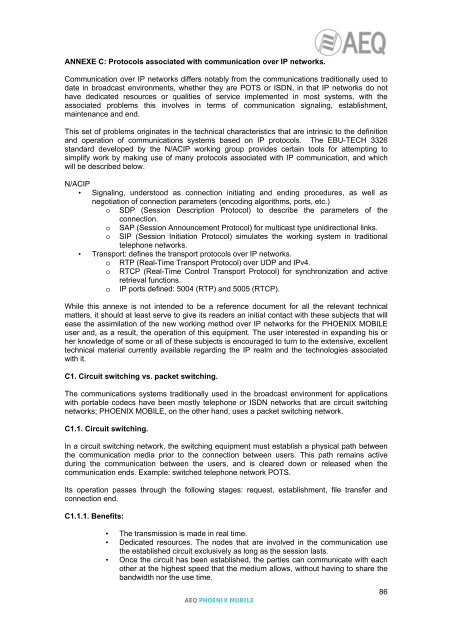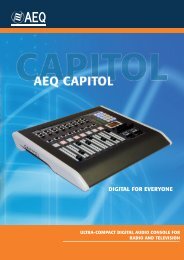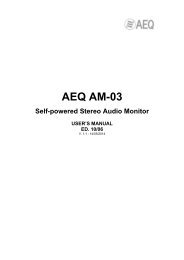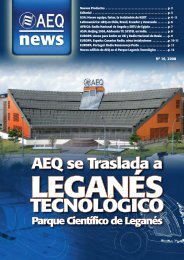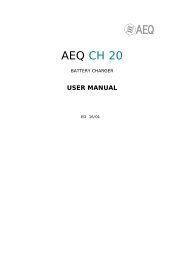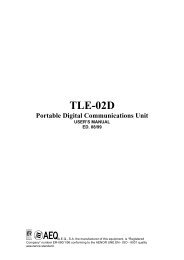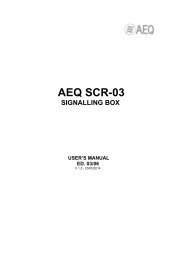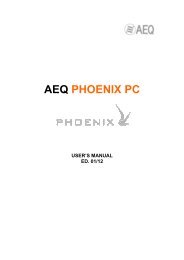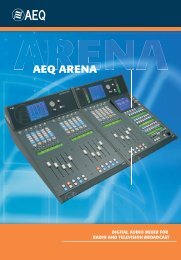Manual - AEQ International
Manual - AEQ International
Manual - AEQ International
Create successful ePaper yourself
Turn your PDF publications into a flip-book with our unique Google optimized e-Paper software.
ANNEXE C: Protocols associated with communication over IP networks.Communication over IP networks differs notably from the communications traditionally used todate in broadcast environments, whether they are POTS or ISDN, in that IP networks do nothave dedicated resources or qualities of service implemented in most systems, with theassociated problems this involves in terms of communication signaling, establishment,maintenance and end.This set of problems originates in the technical characteristics that are intrinsic to the definitionand operation of communications systems based on IP protocols. The EBU-TECH 3326standard developed by the N/ACIP working group provides certain tools for attempting tosimplify work by making use of many protocols associated with IP communication, and whichwill be described below.N/ACIP• Signaling, understood as connection initiating and ending procedures, as well asnegotiation of connection parameters (encoding algorithms, ports, etc.)o SDP (Session Description Protocol) to describe the parameters of theconnection.o SAP (Session Announcement Protocol) for multicast type unidirectional links.o SIP (Session Initiation Protocol) simulates the working system in traditionaltelephone networks.• Transport: defines the transport protocols over IP networks.o RTP (Real-Time Transport Protocol) over UDP and IPv4.o RTCP (Real-Time Control Transport Protocol) for synchronization and activeretrieval functions.o IP ports defined: 5004 (RTP) and 5005 (RTCP).While this annexe is not intended to be a reference document for all the relevant technicalmatters, it should at least serve to give its readers an initial contact with these subjects that willease the assimilation of the new working method over IP networks for the PHOENIX MOBILEuser and, as a result, the operation of this equipment. The user interested in expanding his orher knowledge of some or all of these subjects is encouraged to turn to the extensive, excellenttechnical material currently available regarding the IP realm and the technologies associatedwith it.C1. Circuit switching vs. packet switching.The communications systems traditionally used in the broadcast environment for applicationswith portable codecs have been mostly telephone or ISDN networks that are circuit switchingnetworks; PHOENIX MOBILE, on the other hand, uses a packet switching network.C1.1. Circuit switching.In a circuit switching network, the switching equipment must establish a physical path betweenthe communication media prior to the connection between users. This path remains activeduring the communication between the users, and is cleared down or released when thecommunication ends. Example: switched telephone network POTS.Its operation passes through the following stages: request, establishment, file transfer andconnection end.C1.1.1. Benefits:• The transmission is made in real time.• Dedicated resources. The nodes that are involved in the communication usethe established circuit exclusively as long as the session lasts.• Once the circuit has been established, the parties can communicate with eachother at the highest speed that the medium allows, without having to share thebandwidth nor the use time.<strong>AEQ</strong> PHOENIX MOBILE86


